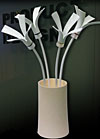Special report on Samsung in French newspaper Le Monde
In the interest of sharing this story with non-French speakers, here is my translation:
Â
Design at the heart of the Samsung strategy
“We have three levels of design analysis: global design intelligence, future design intelligence and corporate design implementation,” says Harry Choi of Samsung’s Corporate Design Center. The text below is based on an interview with him:
- “Global design intelligence”: Six international offices (San Francisco, London, Shanghai, Tokyo, Milan and Bangalore) gather the various sociological trends that characterise the forms, materials and colours of the local design. The experts — architects, interior designers or stylists — do not work full time for Samsung, but are commissioned to regularly brief Samsung on the strategic developments taking place in their geographical area.Â
- “Corporate design implementation”: Here the experts’ information and analyses are reinterpreted from an industrial perspective. It was through the analysis of the products of our various competitors — LG, Bosch, Siemens — that we became fully aware of the coherence of their product line, and the relative incoherence of our own. So we created our Corporate Design Center to create a more integrate design between the products coming from our various activity sectors. We always choose for one single design for a product. It is the same all over the world. It is impossible for us, because of industrial and economic reasons, to develop regional designs. But that doesn’t mean that we do not respond to local needs. For instance, we consider China as a market on its own and we have products there that do not exist anywhere else. We also create “limited edition” series, particularly for the European market, where people are fond of high-end products. We do not make much profit with these products, but they enhance our brand image.Â
- “Future design intelligence”: Here we develop a product roadmap that foresees and prepares our various product lines within a five year time frame. This becomes an important strategic direction for the company, and it is constantly updated. The example of the television is very illustrative. The technology has evolved a lot in five years. We have gone from the Hertz diffusion to TNT, to cable and now to IPTV. The external optical media and their associated connections change practically every year. And the aesthetics are evolving as well.
 Â
Two products, two design strategies
“When we think of a printer nowadays, we think of a noisy, ugly and cumbersome object,” says Jun Won Bae, designer of the SCX 4500 printer. “That was at least the result of our preliminary studies. Based on these findings and on a clear public demand, we decided to devote more attention to the design. We ended up with a trendsetting product.”
“We focussed on four reference values to change the traditional mindset people have of a printer:
- Use value – We reduced the surface and volume of the object to the minimum, by turning it into the smallest laser printer in the world.
- Visual value – We have chosen for a shiny and glossy black. We were inspired by the lacquer of the grand piano and the simple forms this object has. We also avoided the traditional shapes of buttons by creating tactile zones and blue backlit areas to indicate the functions of the printer.
- Tactile value – The materials were chosen for their tactile quality, and are very different from what is usually offered.
- Sound value – We have reduced the printing noise to 45 decibels, from a standard minimum of 50 decibels for other printers.
This small printer is aimed at the SoHo market (small office and housing) but it has a premium price. We want to bring design intot the office, as Apple has successfully done these last few years. In fact, Apple is the exclusive distributor of this product on the American market.
The manufacturing of this printer requires a multitude of skills: mechanical, micro-electronics, chemical (for the inks), and software. This is why there are so few players in this market segment and the Chinese for instance are not attacking us here. We are for now just focusing on a particular sector — laser printers — where we already master the technology. Since we can no longer conquer the market by making conventional printers, we put our energy on design. And for the moment, this strategy is working.”
There is also an interview in this section with the designer of the G800 touch phone.
Â
A university dedicated to R&D
In 1995, Samsung created a design school in Seoul. The Samsung Art and Design Institute (SADI) has meanwhile become a real study laboratory for the group.
Originally the school was dedicated to graphic design and fashion styling. But in the last two years it has opened itself up to industrial design and technology design. Here are some of the student prototypes [which do not seem to be based on much user research].
- Bong-Bong Boxer – Instead of forbidding children to fight with each other, it might make more sense to give them the tools to do so without getting hurt: gloves, “shoes” and a helmet.Â
- Okids phone – This multifunction phone is for the little ones. In phone mode, the child can call preprogrammed numbers and push an emergency button. In “heart” mode, thanks to its ingenious pivotal rotation system, the screen becomes a gaming screen with a separate keyboard.Â
- Talk to me – Each flower is an MP3 recorder and belongs to a member of the family. They can all leave a message on it when leaving the house. When a message is left behind, the lower part of the flower emits a soft pulsing light to indicate that it has something to say.Â
- Spicy cartridge – This box contains little spice containers. A rear projector provides information on each of the containers. It could be part of an intelligent cuisine where recipes are proposed based on the available ingredients.Â
- Mamang – This object reinvents the rocking horse. The child is perched on its back and gets solicited by its parents through the built-in screen and camera.Â
- Take1 – This miniature camera with an omnidirectional screen and built-in tripod, provides bare essential functionality but is highly discrete.Â
- Draw your finger – A mobile phone specially developed for the visually impaired.Â
The report also contains a slideshow of products about to be launched on the market.





Very interesting. Samsung is indeed using design as a strategic advantage. The best example is the digital camera that looks like old, high end German camera.
You have the feeling that own the camera of your childhood. Very impressive.
http://www.dpreview.com/reviews/samsungnv7/
I just regret that you did not translate the interview of the 800 touch phone designer.
So how come Samsung’s phones are so…hapless?
[…] Special report on Samsung in French newspaper Le Monde […]